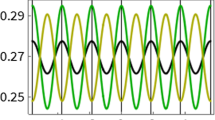Abstract.
We employ the tight binding model to describe the electronic band structure of bilayer graphene and we explain how the optical absorption coefficient of a bilayer is influenced by the presence and dispersion of the electronic bands, in contrast to the featureless absorption coefficient of monolayer graphene. We show that the effective low energy Hamiltonian is dominated by chiral quasiparticles with a parabolic dispersion and Berry phase 2π. Layer asymmetry produces a gap in the spectrum but, by comparing the charging energy with the single particle energy, we demonstrate that an undoped, gapless bilayer is stable with respect to the spontaneous opening of a gap. Then, we describe the control of a gap in the presence of an external gate voltage. Finally, we take into account the influence of trigonal warping which produces a Lifshitz transition at very low energy, breaking the isoenergetic line about each valley into four pockets.
Similar content being viewed by others
References
K.S. Novoselov, A.K. Geim, S.V. Morozov, D. Jiang, Y. Zhang, S.V. Dubonos, I.V. Grigorieva, A.A. Firsov, Science 306, 666 (2004)
K.S. Novoselov, A.K. Geim, S.V. Morozov, D. Jiang, M.I. Katsnelson, I.V. Grigorieva, S.V. Dubonos, A.A. Firsov, Nature 438, 197 (2005); Y.B. Zhang, Y.W. Tan, H.L. Stormer, P. Kim, Nature 438, 201 (2005)
D. DiVincenzo, E. Mele, Phys. Rev. B 29, 1685 (1984)
G.W. Semenoff, Phys. Rev. Lett. 53, 2449 (1984)
F.D.M. Haldane, Phys. Rev. Lett. 61, 2015 (1988); Y. Zheng, T. Ando, Phys. Rev. B 65, 245420 (2002); V.P. Gusynin, S.G. Sharapov, Phys. Rev. Lett. 95, 146801 (2005); N.M.R. Peres, F. Guinea, A.H. Castro Neto, Phys. Rev. B 73, 125411 (2006); A.H. Castro Neto, F. Guinea, N.M.R. Peres, Phys. Rev. B 73, 205408 (2006)
T. Ando, T. Nakanishi, R. Saito, J. Phys. Soc. Jpn. 67, 2857 (1998)
E. McCann, V.I. Fal'ko, Phys. Rev. Lett. 96, 086805 (2006)
K.S. Novoselov, E. McCann, S.V. Morozov, V.I. Fal'ko, M.I. Katsnelson, U. Zeitler, D. Jiang, F. Schedin, A.K. Geim, Nat. Phys. 2, 177 (2006)
T. Ohta, A. Bostwick, T. Seyller, K. Horn, E. Rotenberg, Science 313, 951 (2006)
S.B. Trickey, G.H.F. Diercksen, F. Müller-Plathe, Astrophys. J. 336, L37 (1989); S.B. Trickey, F. Müller-Plathe, G.H.F. Diercksen, J.C. Boettger, Phys. Rev. B 45, 4460 (1992)
S. Latil, L. Henrard, Phys. Rev. Lett. 97, 036803 (2006)
H. Min, B.R. Sahu, S.K. Banerjee, A.H. MacDonald, cond-mat/0612236
K. Yoshizawa, T. Kato, T. Yamabe, J. Chem. Phys. 105, 2099 (1996); T. Yumura, K. Yoshizawa, Chem. Phys. 279, 111 (2002)
C.L. Lu, C.P. Chang, Y.C. Huang, R.B. Chen, M.L. Lin, Phys. Rev. B 73, 144427 (2006); J. Nilsson, A.H. Castro Neto, N.M.R. Peres, F. Guinea, Phys. Rev. B 73, 214418 (2006); M. Koshino, T. Ando, Phys. Rev. B 73, 245403 (2006); F. Guinea, A.H. Castro Neto, N.M.R. Peres, Phys. Rev. B 73, 245426 (2006); M.I. Katsnelson, Eur. Phys. J. B 51, 157 (2006); 52, 151 (2006)
B. Partoens, F.M. Peeters, Phys. Rev. B 74, 075404 (2006)
E. McCann, Phys. Rev. B 74, 161403 (2006)
E.V. Castro, K.S. Novoselov, S.V. Morozov, N.M.R. Peres, J.M.B. Lopes dos Santos, J. Nilsson, F. Guinea, A.K. Geim, A.H. Castro Neto, cond-mat/0611342
J. Nilsson, A.H. Castro Neto, F. Guinea, N.M.R. Peres, Phys. Rev. Lett. 97, 266801 (2006)
D.S.L. Abergel, V.I. Fal'ko, cond-mat/0610673
P.R. Wallace, Phys. Rev. 71, 622 (1947); J.C. Slonczewski, P.R. Weiss, Phys. Rev. 109, 272 (1958)
M.S. Dresselhaus, G. Dresselhaus, Adv. Phys. 51, 1 (2002); R.C. Tatar, S. Rabii, Phys. Rev. B 25, 4126 (1982); J.-C. Charlier, X. Gonze, J.-P. Michenaud, Phys. Rev. B 43, 4579 (1991)
We use γ1=0.39eV [9, 21], v3/v = 0.1, v=8.0×105m/s [2], c0 = 3.35 Å, and εr = 1
Corners of the hexagonal Brilloin zone are \(\mathbf{K} _{\xi }=\xi ({\textstyle\frac{4}{3}}\pi a^{-1},0)\), where ξ=±1 and a is the lattice constant
V. Gusynin, S. Sharapov, J. Carbotte, Phys. Rev. Lett. 96, 256802 (2006); V. Gusynin, S. Sharapov, Phys. Rev. B 73, 245411 (2006)
L. Falkovsky, A. Varlamov, cond-mat/0606800
J. Cserti, Phys. Rev. B 75, 033405 (2007)
K. Nomura, A.H. MacDonald, Phys. Rev. Lett. 96, 256602 (2006); T. Ando, J. Phys. Soc. Jpn. 75, 074716 (2006); V.V. Cheianov, V.I. Fal'ko, Phys. Rev. Lett. 97, 226801 (2006)
In contrast to monolayer graphene, a weak absorption of light polarised perpendicular to the bilayer is possible. A pertubation σz e Ez d / 2 distinguishes between the on-site energies in the top and bottom layers separated by spacing d, which leads to weak absorption g2z=(2πe2/ħc)f2z, \( f_{2}^{z} = %\displaystyle a_{z}^{2}{\rm \Omega} %\displaystyle \left[ \tfrac{1}{{\rm \Omega} +1} + %\displaystyle \tfrac{\theta ({\rm \Omega} -2)}{{\rm \Omega} -1}\right] ,\quad {\rm \Omega} \equiv \hbar {\rm \omega} / \gamma _{1}; \) \(f_{2}^{z}(B,\omega )=%\displaystyle \frac{a_{z}^{2}}{\pi}\sum_{n\geq 2}\frac{\tau \omega }{ \tau ^{2}\omega _{c}^{2}(\frac{\omega } {\omega_{c}}-2\sqrt{n^{2}-n})^{2}+1} \) where the constant az=γ1d/2ħv∼10-1, and the magneto-absorption spectrum at \(\hbar \omega < \frac{1}{4}\gamma _{1}\) involves εn-→εn+ inter-LL transitions
For \(\hbar \omega \ll \frac{1}{4} \gamma_{1}\) this result transforms into f2=1 suggested by J. Cserti [26] for the microwave absorption in bilayer graphene. However one should be aware that equation (6) and conclusions of [26] cannot be applied to \( \hbar \omega \lesssim \epsilon_{\mathrm{L}} = \frac{1}{4} \gamma_{1} (\upsilon_{3} / \upsilon)^{2} \sim 1\)meV. At epsilonF ≈epsilonL, trigonal warping term causes a Lifshitz transition in the topology of the Fermi line in each valley as explained in section 6
F. Léonard, J. Tersoff, Appl. Phys. Lett. 81, 4835 (2002)
K.W.-K. Shung, Phys. Rev. B 34, 979 (1986); E.A. Taft, H.R. Philipp, Phys. Rev. 138, A197 (1965)
G. Dresselhaus, Phys. Rev. B 10, 3602 (1974); K. Nakao, J. Phys. Soc. Jpn. 40, 761 (1976); M. Inoue, J. Phys. Soc. Jpn. 17, 808 (1962); O.P. Gupta, P.R. Wallace, Phys. Stat. Sol. B 54, 53 (1972)
Author information
Authors and Affiliations
Rights and permissions
About this article
Cite this article
McCann, E., Abergel, D. & Fal'ko, V. The low energy electronic band structure of bilayer graphene. Eur. Phys. J. Spec. Top. 148, 91–103 (2007). https://doi.org/10.1140/epjst/e2007-00229-1
Issue Date:
DOI: https://doi.org/10.1140/epjst/e2007-00229-1




